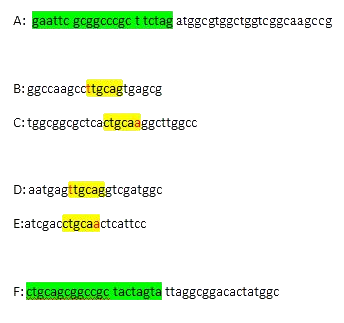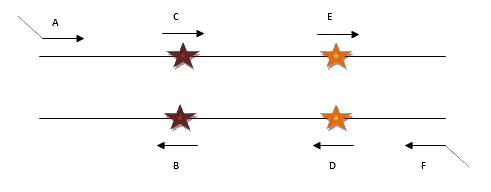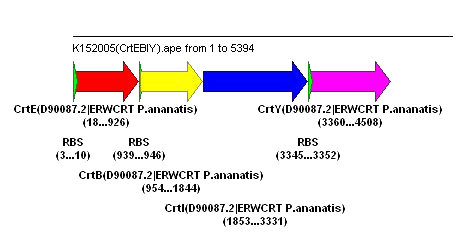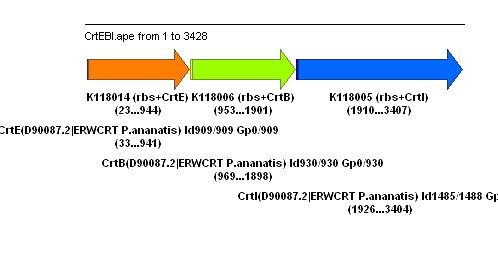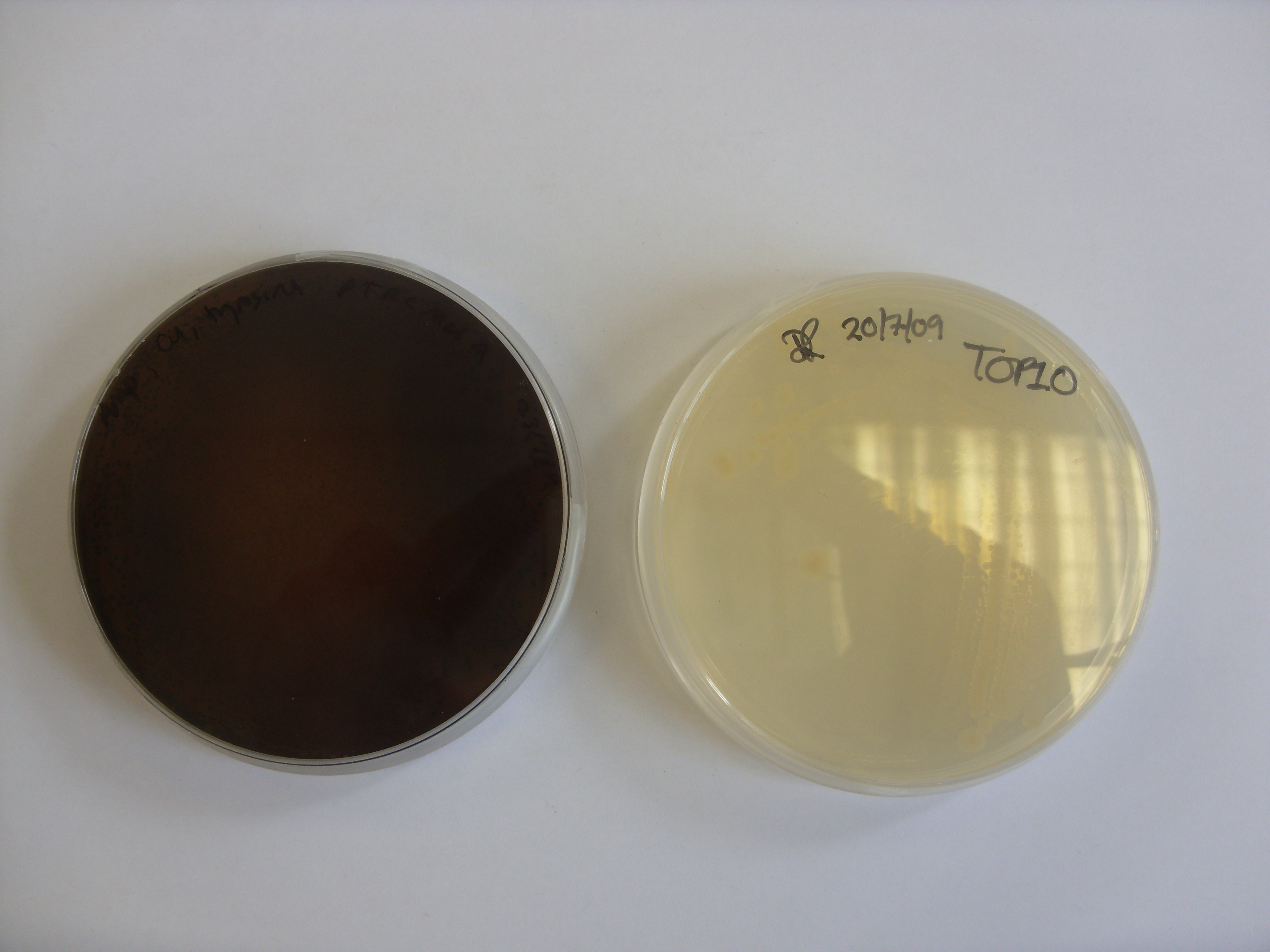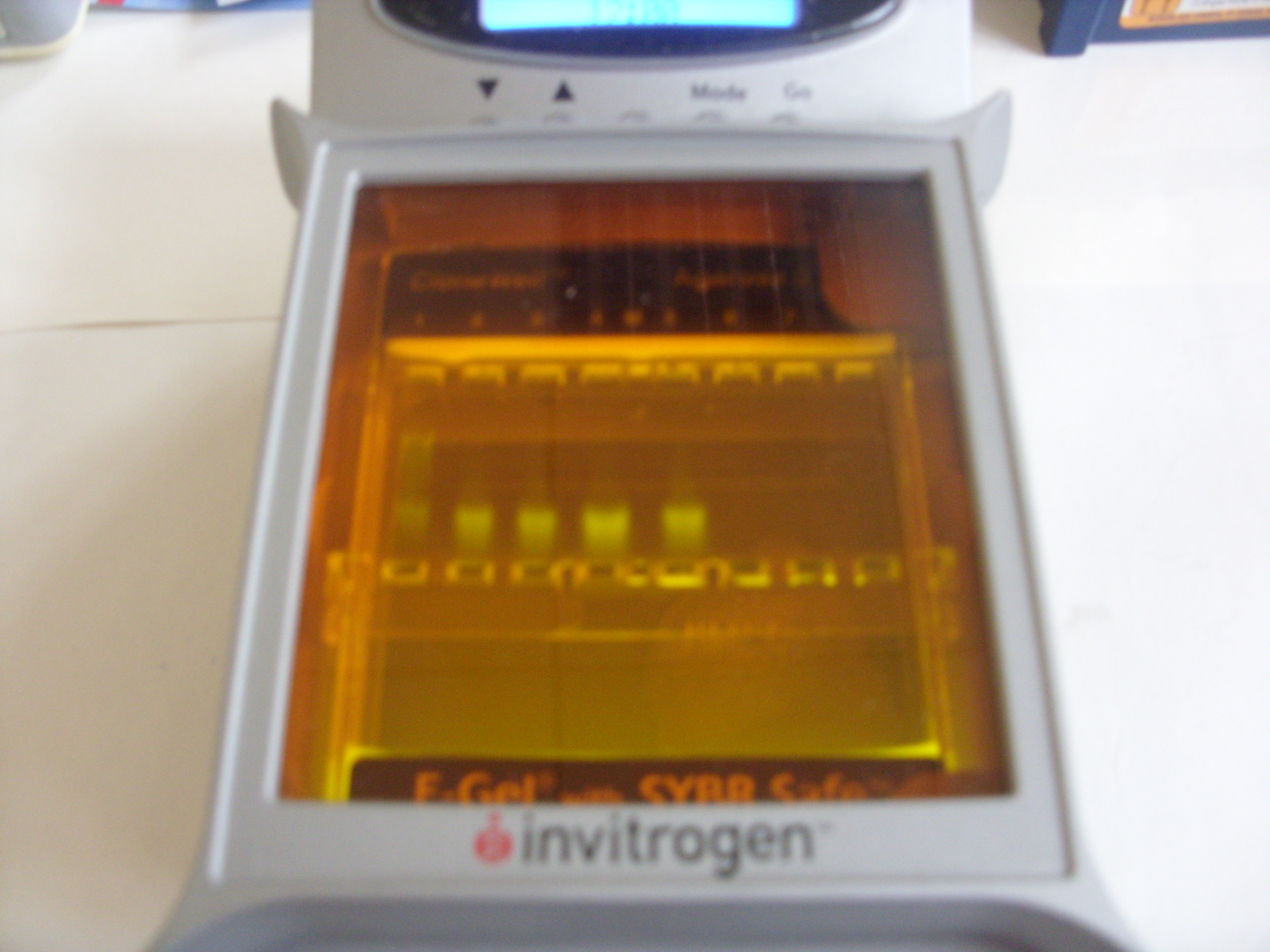Team:Cambridge/Notebook/Week3
From 2009.igem.org
MikeDavies (Talk | contribs) (→Wet Work) |
MikeDavies (Talk | contribs) (→Tuesday) |
||
| Line 114: | Line 114: | ||
==Tuesday== | ==Tuesday== | ||
| - | + | ===Long Term Aims=== | |
| - | + | ====Pigments==== | |
| - | * | + | *Create biobricks |
| - | + | ====Amplification==== | |
| - | * | + | *Find biobricks |
| - | * | + | *Organise system |
| - | * | + | *Transform |
| - | * | + | *Test |
| - | * | + | *Attach to pigments (if time) |
| - | + | ====Degredation Tags==== | |
| - | * | + | *Synthesise |
| - | * | + | *Test |
| - | * | + | *Attach |
| - | + | ====Colour Logic==== | |
| - | * | + | *Get colour biobricks |
| - | * | + | *Attach inducible promoters |
| - | * | + | *Test |
| - | + | ===Results of Melanin transformation=== | |
[[Image:SDC10545.JPG|300px]] | [[Image:SDC10545.JPG|300px]] | ||
| Line 145: | Line 145: | ||
The plate on the right is the control plate, containing untransformed TOP10 E. coli. These were the cells used for the transformation. | The plate on the right is the control plate, containing untransformed TOP10 E. coli. These were the cells used for the transformation. | ||
| - | + | ===Wet Work=== | |
| - | + | ====Colony PCR==== | |
*K152005 | *K152005 | ||
*R0011 | *R0011 | ||
| Line 158: | Line 158: | ||
After the PCR run the products were run out on a gel (15ul of PCR product with 2ul of 1X loading buffer were added to a 0.8% agarose Invitrogen E-GEL and run for 30 mins). | After the PCR run the products were run out on a gel (15ul of PCR product with 2ul of 1X loading buffer were added to a 0.8% agarose Invitrogen E-GEL and run for 30 mins). | ||
| - | + | ====Mini Prep==== | |
*K152005 | *K152005 | ||
*R0011 - not a high enough concentration of plasmid DNA, will have to cut out of gel from colony PCR | *R0011 - not a high enough concentration of plasmid DNA, will have to cut out of gel from colony PCR | ||
| - | * | + | *Violacein cultures didn't grow overnight, will try again tomorrow with new cultures |
*Melanin | *Melanin | ||
*Used nanodrop spectrophotometer to measure DNA concentration. | *Used nanodrop spectrophotometer to measure DNA concentration. | ||
| - | + | ====Preparation for Colony PCRs and Minipreps for Tomorrow==== | |
| - | * | + | *Overnight cultures of the cultures containing the following plasmids in LA with the appropriate antibiotic |
| - | + | :*K118005 (amp) | |
| - | + | :*K118006 (amp) | |
| - | + | :*K118013 (amp) | |
| - | + | :*K118014 (amp) | |
| - | * | + | :*Violacein (trimethoprim) |
| - | + | ====New E. Coli Strains==== | |
*Roche parent strain and FPP high flux strain, for orange plasmid | *Roche parent strain and FPP high flux strain, for orange plasmid | ||
| - | * | + | *Prepared to make competent cells tomorrow |
====Amplification system plan==== | ====Amplification system plan==== | ||
| - | *Wednesday | + | *'''Wednesday''' |
:*Prepare to make arabinose strain (BW27783) competent | :*Prepare to make arabinose strain (BW27783) competent | ||
:*Incubate single colony overnight | :*Incubate single colony overnight | ||
:*Make more amp plates if necessary | :*Make more amp plates if necessary | ||
| - | *Thursday | + | *'''Thursday''' |
:*Do competent cell protocol | :*Do competent cell protocol | ||
:*Transform all 15 combination constructs. | :*Transform all 15 combination constructs. | ||
:*Plate (30 amp plates) | :*Plate (30 amp plates) | ||
| - | *Friday | + | *'''Friday''' |
:*Hope they grew | :*Hope they grew | ||
| - | + | *'''Sunday''' | |
:*Incubate single colonies overnight in culture | :*Incubate single colonies overnight in culture | ||
| - | *Monday | + | *'''Monday''' |
:*Colony PCR of each | :*Colony PCR of each | ||
:*PCR low copy plasmid | :*PCR low copy plasmid | ||
| - | *Tuesday | + | *'''Tuesday''' |
:*Use plate reader to gather data for the 15 combination constructs in BW27783 cells on high copy number plasmid after induction with arabinose | :*Use plate reader to gather data for the 15 combination constructs in BW27783 cells on high copy number plasmid after induction with arabinose | ||
:*Assembly: restriction digest of combination constructs, ligation into low copy plasmid | :*Assembly: restriction digest of combination constructs, ligation into low copy plasmid | ||
:*Transform new constructs into Top10 | :*Transform new constructs into Top10 | ||
:*Plate (30 kan plates) | :*Plate (30 kan plates) | ||
| - | *Wednesday | + | *'''Wednesday''' |
:*Colony PCR of new constructs the sneaky way | :*Colony PCR of new constructs the sneaky way | ||
:*Incubate single colonies overnight in culture | :*Incubate single colonies overnight in culture | ||
| - | *Thursday | + | *'''Thursday''' |
:*Colony PCR of new constructs if yesterdays didn’t work | :*Colony PCR of new constructs if yesterdays didn’t work | ||
:*Miniprep | :*Miniprep | ||
:*Transform into BW27783 strain | :*Transform into BW27783 strain | ||
:*Plate (30 kan plates) | :*Plate (30 kan plates) | ||
| - | *Friday | + | *'''Friday''' |
:*Do another plate reader analysis after induction with arabinose | :*Do another plate reader analysis after induction with arabinose | ||
Revision as of 16:23, 29 July 2009
Categories :
Project :
-
Overview
Sensitivity Tuner
--- Characterisation
--- Modelling
Colour Generators
--- Carotenoids (Orange/Red)
--- Melanin (Brown)
--- Violacein (Purple/Green)
The Future
Safety
Notebook :
Team Logistics :
Week 3 - Development
Monday
Primer Design
Primers were designed to convert MelA into a biobrick. Primers A and F are for either end (including prefix and suffix - highlighted in green). The other primers surround the unwanted restiction sites (highlighted in yellow) with the changed base in red.
These correspond to the parts on the gene shown below. The stars correspond to the two unwanted restriction sites.
Orange Pigment
Used plasmid editor to examine the genes used for the production of orange pigments. The (supposedly) orange-producing pigment from the biobricks:
We also tried a preliminary design for a biobrick we could construct, in case the orange biobrick does not function. This uses the same genetic synthetic pathway for gene consruction:
Transformed Pigments
The MelA plate left on the bench overnight produced a brown-coloured pigment! Growth on media containing IPTG should produce this pigment a lot faster.
Amplification system
- Possible plan
- We would want to tag the activator proteins then quantify their degradation in some way
- GFP fusion: one idea was to create a functional activator-GFP fusion, to which we would then add a C-terminal degradation tag. Thus we could express the activator-GFP-tag in E. coli, and could measure flourescence to quantify activator degradation directly. However, this idea depends on us constructing a functional activator-GFP fusion.
- Western blotting: a second idea is to add an N-terminal flag tag to the activator proteins, and then add the C-terminal degradation tag. We could measure the amount of activator using Western blotting and an anti-flag antibody by taking samples over time. However, Western blotting isn't that easy.
- Finally, what we're really doing is solving a problem found in the Cambridge 2007 team's system. If we can show that overnight bacterial growth is less hindered with our tagged activators, then we are effectively showing that because of the degradation tags, the activators are indeed being degraded.
- We could also attempt to see what this effect has on amplification
- Modelling potential - activator half life, change in Pops out?
- First we need to dig up the 2007 work and recreate their data, this time with a plate reader that can take OD and fluorescence readings simultaneously.
Activators
- Found parts submitted by Cambridge '07 team amplifier project. Three translational units (ribosome binding sites and protein coding sequence) for the three activators. Sequence below, 5' to 3':
- Ogr activator from P2 phage: Part I746350
>BBa_I746350 Part-only sequence (237 bp)
aaagaggagaaatactagatgtttcattgtcctttatgccagcatgccgcacatgcgcgtacaagtcgctatatcactgacacgacaaaagagcgttatc
atcagtgccagaacgtgaattgcagcgccacgttcatcacttatgagtcggtacagcgatacatcgtgaagccgggagaagtccacgccgtaaggccgca
cccgttgccatcagggcagcaaattatgtggatgtaa
- pag activator from PSP3 phage: Part I746351
>BBa_I746351 Part-only sequence (237 bp) aaagaggagaaatactagatgatgcactgcccgttatgccaaaacgctgcacatgctcgcactagccggtaccttagcaccgaaacgaaagaacgttatc accagtgccaaaacataaattgcggatgtacatttatcacttttgagacactatcaagattcattgtgaaaccggggactgttgatcctgctccgcccca ccccatcagaaaccaacaacagcaactttggctttga
- delta activator from phiR73 phage: Part I746352
>BBa_I746352 Part-only sequence (264 bp) aaagaggagaaatactagatgatgcgctgccctttctgtcgtcattcagcgcatacccgcaccagccggtatgtgagtgacaatgtcaaagaaagttatc tccagtgccagaatatttactgttcggcgacatttaaaacgcatgagtcaatttgtgccgtgattcgttctccggtcacggaggaaaaaccagcaccggc aagcacagcaccggctgttgtccgaaaagttaaaggctgttacagctcaccattcaaccattaa
(delete sequence if you think its unnecessary and just leave part names)
Promoters
Available as individual parts, with a GFP reporter or as part of a composite with the activator upstream. Five promoters as used by Cambridge '07:
PF promoter, part: I746360 PO promoter, part: I746361 PP promoter, part: I746362 Psid promoter, part: I746364 PLL promoter, part: I746365
Degradation Tags
- three C-terminal tags are well described in Andersen, J. B., Sternberg, C., Poulsen, L. K., Bjorn, S. P., Givskov, M. & Molin, S. (1998). New unstable variants of green fluorescent protein for studies of transient gene expression in bacteria. Appl Environ Microbiol 64, 2240–2246.[http://aem.asm.org/cgi/reprint/64/6/2240], which detailed tagged-GFP degredation.
- the tags as described in the paper that we could use are as follows (all DNA sequences are 5' to 3')
- LAA: amino acid sequence AANDENYALAA, DNA sequence GCAGCAAACGACGAAAACTACGCTTTAGCAGCT
(primer – CGTCGTTTGCTGCTTTTGATGCGAAATCGTCGA) (currently the "planning" biobrick BBa_M0042)
- AAV: amino acid sequence AANDENYAAAV, DNA sequence GCAGCAAACGACGAAAACTACGCTGCAGCAGTT
(primer – CGTCGTTTGCTGCTTTTGATGCGACGTCGTCAA, currently the "planning" biobrick BBa_M0044 with DNA sequence GCAGCAAACGACGAAAACTACGCTGCTGCTGTT)
- NOTE: we need to use the biobrick DNA sequence as the DNA sequence described in the paper has a forbidden PstI site
- ASV: amino acid sequence AANDENYAASV, DNA sequence GCAGCAAACGACGAAAACTACGCTGCATCAGTT
(primer – CGTCGTTTGCTGCTTTTGATGCGACGTAGTCAA, currently the "planning" biobrick BBa_M0046 with DNA sequence GCTGCAAACGACGAAAACTACGCTGCATCAGTT)
Wet Work
- Made up 4 15ug/mL tetracycline agar plates - argh should have been trimethoprim!
- Electroporated the following plasmids into our TOP10 competent E. coli cells
- K118005
- K118006
- K118013
- K119014
- Orange plasmid from Dupont strain
- Plated each biobrick out onto ampicillin plates, plated the orange plasmid onto a tetracycline plate, left to incubate overnight
- Innoculated 6 single colonies from each of the following cultures, grown over the weekend on plates, in the appropriate antibiotic LB to shake over night in preparation for minipreps and colony PCRs tomorrow
- Violacein plasmid
- Melanin plasmid
- K152005
- R0011
Amplifiers
Basal amplification could potentially be reduced by using a suppressor. The "amplification factors" from Cambridge 2007 appear to be long term, ie steady state. It would be interesting to look at the transient response, as the degradation rate will have an impact on this.
Tuesday
Long Term Aims
Pigments
- Create biobricks
Amplification
- Find biobricks
- Organise system
- Transform
- Test
- Attach to pigments (if time)
Degredation Tags
- Synthesise
- Test
- Attach
Colour Logic
- Get colour biobricks
- Attach inducible promoters
- Test
Results of Melanin transformation
Plate on the left is the melA plasmid plated on LB agar with 15ug/ml copper, 0.2ug/ul tyrosine and 100ug/ml Amp. The plate was incubated at 37 degrees for 24 hours and then left on the bench at room temperature over the weekend. Quicker induction of the melanin would be achieved by growing on plates containing IPTG. The relative concentrations of copper, tyrosine and IPTG could also be optimised.
The plate on the right is the control plate, containing untransformed TOP10 E. coli. These were the cells used for the transformation.
Wet Work
Colony PCR
- K152005
- R0011
PCR cycle = two minutes at 98 degrees followed by thirty cycles:
- Denaturation 98 degrees 30 seconds
- Annealing 65 degrees 30 seconds
- Elongation 22 degrees 3 minutes
Followed by a final elongation at 72 degrees for 10 minutes.
After the PCR run the products were run out on a gel (15ul of PCR product with 2ul of 1X loading buffer were added to a 0.8% agarose Invitrogen E-GEL and run for 30 mins).
Mini Prep
- K152005
- R0011 - not a high enough concentration of plasmid DNA, will have to cut out of gel from colony PCR
- Violacein cultures didn't grow overnight, will try again tomorrow with new cultures
- Melanin
- Used nanodrop spectrophotometer to measure DNA concentration.
Preparation for Colony PCRs and Minipreps for Tomorrow
- Overnight cultures of the cultures containing the following plasmids in LA with the appropriate antibiotic
- K118005 (amp)
- K118006 (amp)
- K118013 (amp)
- K118014 (amp)
- Violacein (trimethoprim)
New E. Coli Strains
- Roche parent strain and FPP high flux strain, for orange plasmid
- Prepared to make competent cells tomorrow
Amplification system plan
- Wednesday
- Prepare to make arabinose strain (BW27783) competent
- Incubate single colony overnight
- Make more amp plates if necessary
- Thursday
- Do competent cell protocol
- Transform all 15 combination constructs.
- Plate (30 amp plates)
- Friday
- Hope they grew
- Sunday
- Incubate single colonies overnight in culture
- Monday
- Colony PCR of each
- PCR low copy plasmid
- Tuesday
- Use plate reader to gather data for the 15 combination constructs in BW27783 cells on high copy number plasmid after induction with arabinose
- Assembly: restriction digest of combination constructs, ligation into low copy plasmid
- Transform new constructs into Top10
- Plate (30 kan plates)
- Wednesday
- Colony PCR of new constructs the sneaky way
- Incubate single colonies overnight in culture
- Thursday
- Colony PCR of new constructs if yesterdays didn’t work
- Miniprep
- Transform into BW27783 strain
- Plate (30 kan plates)
- Friday
- Do another plate reader analysis after induction with arabinose
Wednesday
Dry Work
Organising a road-map for the procedures, to be presented at the meeting tomorrow
Wet Work
Miniprep
Violacein - got a decent DNA concentration this time.
Making more competant cells
We made the MG1655 Roche and Parent strains competant. The Roche strain has been modified from the parent strain in order to upregulate the pathways that produce the precursors for the orange pigment. We aim to transform both of them with the orange plasmid from Duncan and the orange pigmented biobrick in order to compare the difference in pigment intensity.
We also started the procedure to make strain BW27783 competent. This strain constitutively expresses arabinose transporters and is perhaps better suited to arabinose induction for the amplification project.
Testing DNA ladders
We ran a quick gel to test the ladders in the freezer from the iGEM competition last year (using the 0.8% agarose Bioline E-GELs). All hyperladders were confirmed to be working. It was decided to order more Hyperladder I as this gives the most useful spread of bands for the DNA we will be working with. This was also a test of the E-GEL system confirming the gels worked well.
Picture above shows the PCR test run for the ladders. From left: hyperladder I, four samples of hyperladder IV found in the freezer. There were no meaningful results from the PCR run, so we went back to check over the proceedure for errors.
Transformations
We transformed Duncan's orange plasmid into Top10, Roche, and parent strain competent cells. Plated onto chloramphenicol and tetracycline plates, as we're not 100% sure o the antibiotic resistance properties of the plasmid.
 "
"
